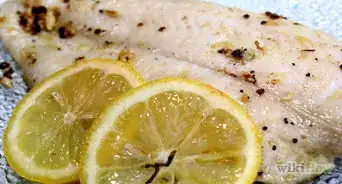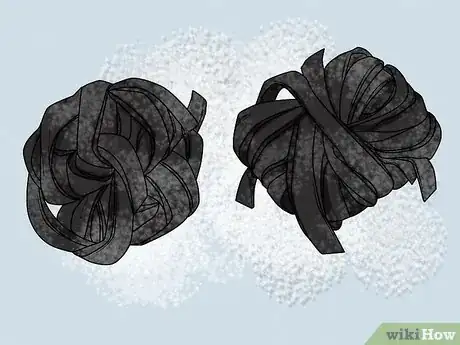This article was co-authored by Alex Hong and by wikiHow staff writer, Dan Hickey. Alex Hong is the Executive Chef and Co-Owner of Sorrel, a New American restaurant in San Francisco. He has been working in restaurants for over ten years. Alex is a graduate of the Culinary Institute of America, and has worked in the kitchens of Jean-Georges and Quince, both Michelin-starred restaurants.
There are 15 references cited in this article, which can be found at the bottom of the page.
This article has been viewed 2,659 times.
If you’ve never had squid ink before, your first thought might not be “Mmm, delicious!” However, this versatile, bluish-black substance that cephalopods use to escape from predators is a tasty addition to many pasta, rice, and seafood dishes. The best part is, it’s super easy to cook with, too. In this article, we’ll walk you through squid ink’s complex flavor, how it’s used in recipes, and even show you how to extract it from a fresh squid yourself. Read on to wow your friends with a striking black recipe at your next dinner party—you could even use the ink to write about how delicious it was!
Things You Should Know
- Squid ink has a subtle, salty, briny flavor that works well in a variety of dishes like pasta, rice, bread, and even ice cream or cocktails.
- Squid or cuttlefish ink is available online or at high-quality seafood, Italian, Spanish, or Japanese markets.
- To extract ink, prep a squid the same way you would for calamari. Instead of tossing the organs, cut off the silvery ink sac and squeeze the ink into a bowl.
Steps
Squid Ink Taste
-
Squid ink has a briny, salty taste that some describe as “like the sea.” The saltiness is similar to oysters, but there is a silky, complex umami flavor that’s unique to squid and cuttlefish inks. Squid ink has a fairly neutral ocean taste on its own, so it absorbs its unique flavors from the squid, sea salt, and ocean water.[1] X Research source
- The taste of squid ink isn’t very overpowering when it’s used in recipes, so it adds a subtle, delicious, briny layer to whatever dish it’s in.
What is squid ink?
-
Squid ink is the bluish-black fluid that cephalopods use for defense. When a squid, octopus, or cuttlefish is threatened, it releases ink into the water to obscure its predator’s vision and escape. The dark color comes from melanin—the same pigment that colors human skin. The ink is stored in a sac near the squid’s gills and in smaller sacs behind its eyes.[2] X Research source
- Cuttlefish ink tastes very similar to squid ink and is a shade of very dark brown rather than bluish-black. The two are interchangeable in recipes.
Where can I find squid ink?
-
Squid ink is available online or in international and seafood markets. A quality Italian, Spanish, Japanese, or seafood specialty shop will probably have squid ink (or at least a specialist who can help you track some down). It’s generally easier to find if you live along the coasts than if you’re in a landlocked area. There are also gourmet food sites that sell jars or packets of ink for cooking.[3] X Research source
Is squid ink safe to eat?
-
Squid ink is safe to eat if you don’t have a seafood or shellfish allergy. Despite its striking black color, squid and cuttlefish ink are not poisonous or toxic to humans at all. The only danger might be accidentally staining your clothes while you’re cooking or eating it! Don’t worry if your teeth or lips are a little black after dinner—the tint will fade away quickly.[4] X Research source
- Avoid eating squid ink if you have a seafood or shellfish allergy.
Health Benefits
-
Squid ink has impressive antimicrobial and antioxidant properties. Studies have shown that the ink can neutralize bacteria that cause dental plaque and foodborne illnesses like E. coli. Its antioxidant properties are also thought to prevent cell damage from free radicals that cause cancer, heart disease, or diabetes. The compounds in squid ink might also help develop immune cells, prevent ulcers, and help blood vessels dilate.[5] X Research source
- Most of the studies about squid ink benefits have been performed in test tubes or in animals. More research is needed to confirm its benefits for humans.
- Squid ink contains melanin, a variety of amino acids, metals like cadmium and copper, enzymes, polysaccharides, and catecholamines.
Culinary Uses
-
1Black pasta is one of the most popular uses of squid ink. The ink gives the noodles a striking color and adds a very subtle, briny flavor that really accentuates seafood pasta dishes. The ink flavor blends harmoniously with other flavors in the dish and is rarely overpowering (unless you accidentally add too much!).[6] X Research source
- Sometimes the ink is used in a white wine sauce and added on top of regular pasta. It’s a great way to get the flavor, but the color isn’t as striking.
-
2Squid ink can also color and flavor rice. For example, Spanish paella with black rice (called arroz negro) is a popular and beautiful dish made with squid ink. The ink stains the outside of rice grains and adds a salty, umami flavor that’s deep and smooth. Black rice can also be used to make sushi, side dishes, or any other recipe with rice.[7] X Research source
-
3Squid ink acts like a tasty food coloring in bread and buns. Unlike in pasta or rice dishes, the ink flavor is very, very faint when it’s baked in bread. If you’re eating plain bread, you might get a hint of salty brine, but any spreads or sandwich ingredients will overpower the flavor. Black bread is very eye-catching though, and some restaurants incorporate it into their menus around Halloween.[8] X Research source
-
4A few drops of squid ink can dye and flavor soups and sauces. This is especially common with seafood soups and dishes or certain pasta sauce recipes, but the mild and versatile flavor can be easily added to any dish. The next time your soup needs a little more salt and complexity, squid ink might be the solution![9] X Research source
-
5Squid ink enhances the flavors of other seafood dishes. It can be added to almost any dish for a little extra brine and a punch of black color. Some recipes include black sushi rice, fish ‘n’ chips made with a black batter, seafood tacos on squid ink tortillas, black calamari, and black tempura.[10] X Research source
-
6Squid ink is so versatile, it can even be used to make black ice cream. In some Korean cities and fish markets, it’s an in-demand sweet treat that became more widely known during the 2018 Olympics. The salty sweetness tastes almost like salted caramel or a slight chocolate flavor. It might look bizarre, but it tastes fantastic![11] X Research source
-
7A few drops of squid ink can take cocktails to the next level. The ink is pretty concentrated, so you only need a few drops to make a tasty, mysteriously black beverage. The salty brine pairs well with the olive taste of martinis or even the licorice taste of absinthe. Any cocktail you might pair with oysters or seafood might benefit from a few drops, too.[12] X Research source
Cooking with Squid Ink
-
1Use squid ink sparingly and add it to recipes while the food is cooking. Unless you’re making something like bread or pasta and need to mix it into dough first, add your ink while rice, soups, or sauces are simmering so the flavor can blend evenly into the dish. Follow recipe amounts carefully and don’t add extra ink unless you’re making an extra big batch of something. Most recipes that serve 4-8 people only call for a few teaspoons of squid ink at most.
- Even a giant paella that serves 6 only needs 3 tsp (15 mL) of ink.[13] X Research source
- If you’re freestyling, be conservative with how much ink you add (you can always try your recipe again with a larger amount next time!).
-
2Add ink to pasta dough to make homemade noodles black. Follow any noodle dough recipe as written, but with one small addition—when it comes time to add eggs to your dry ingredients, just pour your ink alongside them. For a recipe that serves 4-6 people, add 4 tsp (20 mL) of squid ink.[14] X Research source
- Try pre-made black pasta if you can’t locate quality squid ink. Purchase the black noodles and boil them until they’re soft, just like regular noodles.
Extracting Ink Yourself
-
1Buy a fresh squid that hasn’t been cleaned or prepared yet. Look for one with a shiny and slightly translucent appearance and avoid slimy or dull looking squids. Ask the fishmonger to remove the ink sac for you, or take the entire squid home to prepare yourself.[15] X Research source
- Fresh squid is available at most seafood markets, or even local farmers’ markets if you live on the coasts.[16] X Research source
-
2Pull the finned tube away from the head and tentacles. Work over the sink with gloves on, since this can get a bit messy. Grab the tube (the long, cone-shaped part of the squid’s body) in one hand and the squid’s head in the other and gently pull them apart. The head should pop off easily and pull the squid’s organs out with it. Put your fingers inside the tube and pull out the transparent, plastic-looking cartilage inside and discard.[17] X Research source
- Be careful not to squeeze anything above the eyes or you might pop the ink sac.
- Set the tube aside for rinsing, slicing, and cooking once the organs are removed.
-
3Make a slice between the squid’s eyes and the tentacles. Feel around for a hard beak inside the tentacles and pull it out with your hands, then discard it. Set the tentacles aside for rinsing and cooking. You’re now left with the squid’s eyes, head, and internal organs.[18] X Research source
-
4Use a sharp knife to slice the ink sac away from the squid’s body. Look for a small, thin, silvery sac about halfway up the squid’s body. The sac is attached by both ends, so slide a knife underneath it and slice outwards to sever it from the body. Be very cautious since an accidental puncture can send stain-making ink all over your clothes and kitchen.[19] X Research source
- Discard the internal organs, but save the head to access the ink behind the eyes.
-
5Hold the sac over a bowl or container and gently puncture it with a knife. Squeeze all of the ink into the container (try to use ceramic or glass since the ink can stain plastic bowls). Keep squeezing until there is no longer any black liquid dripping out. Be extra careful with smaller sacs since the pressure might make them spray ink more intensely.[20] X Research source
- If you’re waiting to empty the ink sac until later in the recipe, place it in a bowl and cover it with a damp cloth to keep it from drying out.[21] X Research source
-
6Squeeze ink out of the deposits behind the squid’s eyes. Look near the slice you made earlier between the eyes and the tentacles—you should see black ink deposits behind the squid’s silvery retinas. Poke your knife into the ink and then squeeze the squid over your ink bowl to get the last few drops of ink, then repeat on the other eye.[22] X Research source
- Discard the squid’s head. The tube and tentacles can be used for making calamari, seafood soups, and other recipes.
Warnings
- Do not eat squid ink if you have any allergy to squid, shellfish, or seafood.[23] X Research source⧼thumbs_response⧽
You Might Also Like







Expert Interview
References
- ↑ https://www.fanaticallyfood.com/what-does-pasta-with-squid-ink-taste-like/
- ↑ https://endzonescore.com/what-does-squid-ink-taste-like/
- ↑ https://endzonescore.com/what-does-squid-ink-taste-like/
- ↑ https://thekitchenjournal.com/what-does-squid-ink-taste-like/
- ↑ https://www.researchgate.net/publication/328790300_Medicinal_and_therapeutic_properties_of_cephalopod_ink_a_short_review
- ↑ https://thekitchenjournal.com/what-does-squid-ink-taste-like/
- ↑ https://tastecooking.com/recipes/arroz-negro-spanish-squid-ink-rice/
- ↑ https://thekitchenjournal.com/what-does-squid-ink-taste-like/
- ↑ https://saciado.com/squid-ink-taste/
- ↑ https://www.therecipe.com/food-items-made-squid-ink/
- ↑ https://www.si.com/eats/2018/02/15/pyeongchang-winter-olympics-korean-food-tour
- ↑ https://craftandcocktails.co/2016/10/31/spooky-squid-ink-classic-cocktails/
- ↑ https://www.foodnetwork.com/recipes/tyler-florence/squid-ink-paella-6581324
- ↑ https://www.seriouseats.com/squid-ink-pasta-black-recipe
- ↑ https://www.abc.net.au/everyday/how-to-prepare-and-cook-squid-calamari/10548256
- ↑ https://www.bonappetit.com/test-kitchen/ingredients/article/how-to-cook-squid-right
- ↑ https://www.bonappetit.com/test-kitchen/ingredients/article/how-to-cook-squid-right
- ↑ https://www.bonappetit.com/test-kitchen/ingredients/article/how-to-cook-squid-right
- ↑ https://makezine.com/projects/extract-and-use-squid-ink/
- ↑ https://makezine.com/projects/extract-and-use-squid-ink/
- ↑ https://www.giallozafferano.com/recipes/Squid-ink-linguine.html
- ↑ https://makezine.com/projects/extract-and-use-squid-ink/
- ↑ https://thekitchenjournal.com/what-does-squid-ink-taste-like/
About This Article


































































